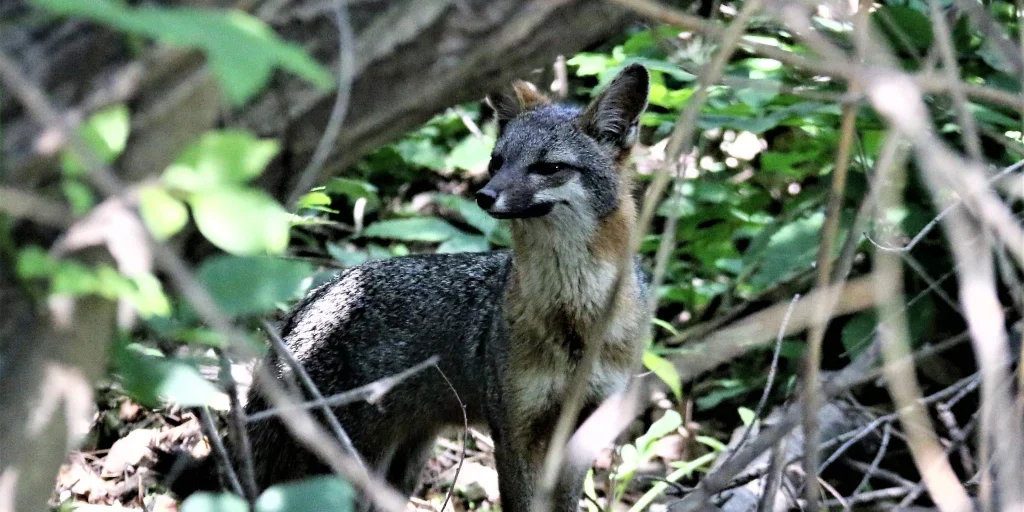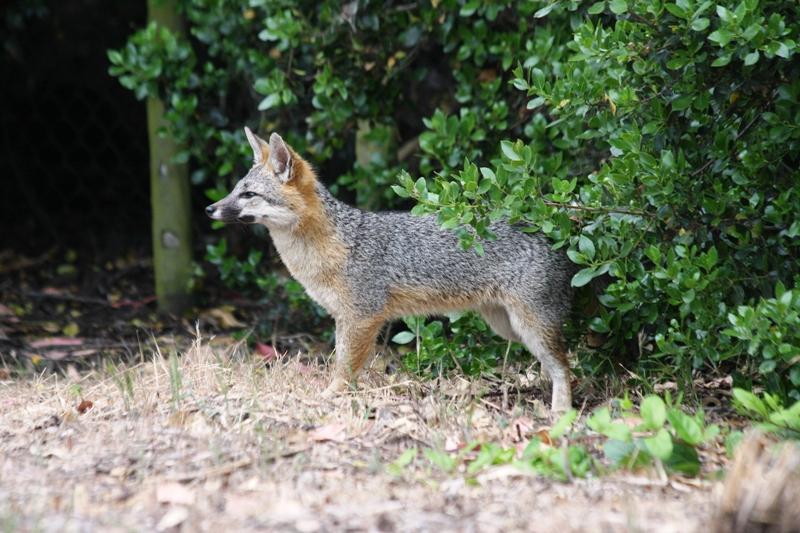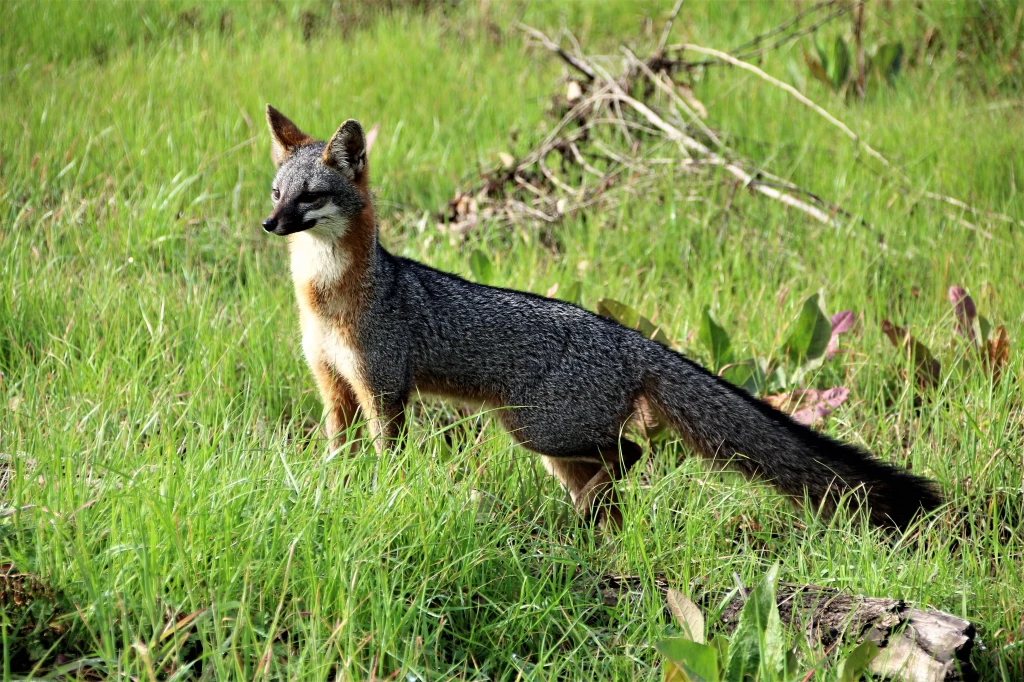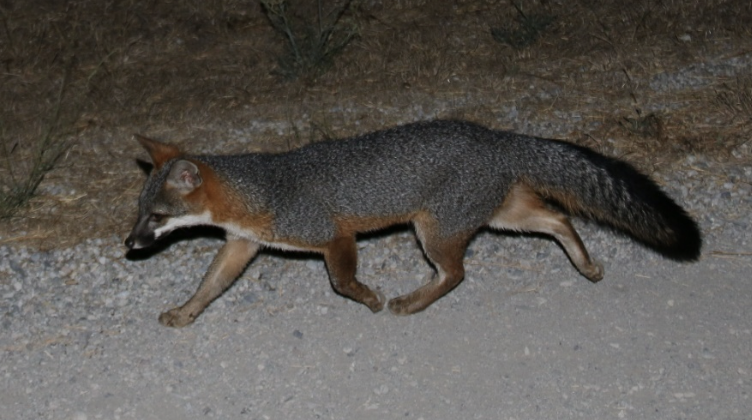Normalcy In the Baylands
by William C. Leikam
President, CEO & Co-founder, Urban Wildlife Research Project

It’s hot out there but that breeze takes the edge off a bit. I had to go out this afternoon and take care of two cameras down in the channel. That concrete sure reflects the heat.
Anyway, I leave for my annual trek deep into the Badger – Two Medicine Wilderness up there in Montana on Wednesday 6/22/2022. Therefore, I won’t be making my usual monthly Gray Fox Report However, I will just say that in regards to the gray fox pair over on Matadero Creek, there’s really nothing much to report. There have been no unusual or noteworthy events over this past month. They remain very healthy as noted in their scat and from direct observation. Most often prior to the die-out of 2016 almost all of those foxes harbored intestinal worms, but these two show no sign of having worms. That’s good because it means that their immune system is healthy. The one thing that is not generally good with that pair is that they came into the area in February 2019 and for all the time that they have been in the baylands, they have not had pups. Indications are that one or both of the foxes has problems with their reproductive system.
Please consider the foregoing as the May Gray Fox Report.
Miscellany:
The beaver in Matadero creek has been showing up about once a month. It appears as if the coyote pair have vacated the territory as they have not shown on my trail cameras since May 7th.
Aside from all of that and just FYI, in late April I flew to Zurich to take part in the project Triggered by Motion (https://www.planetdigital.ch/en/project/triggered-by-motion ) that we contributed wildlife files from the baylands to for 1.5 years. The University of Zurich people treated us – myself and my videographer — like celebrities. A documentary is being made from the film taken on that trip. For next year I have been tentatively invited to make a presentation about the baylands foxes in Estonia. Here is the link to that conference for this year https://biotoopia.ee/online-conference/ It looks as though I am gaining an international reputation.
I will likely be in collaboration with Dr. David Pena-Guzman at SF State University on several theoretical issues related to the cognitive processes of the gray fox and other critters. We have just now opened a dialogue between the two of us.
We are stakeholders with the City of Mountain View on their new Wildlife Management Plan.
Gray Foxes General Health
These two foxes appear to be in good health. The previous indication that one of them may have worms has not proven to be the case.
Total Numbers of Gray Foxes in the Palo Alto Baylands Nature Preserve
As of this date, we have two adult gray foxes living in the Palo Alto Baylands Nature Preserve.
Section II
Update for the Urban Wildlife Research Project
Bill’s new book The Road to Fox Hollow has been released and can be found at Barnes & Noble Booksellers https://www.barnesandnoble.com/w/the-road-to-fox-hollow-wc-leikam/1140931306?ean=9781955690072 and directly from the publisher Di Angelo Publications at https://www.diangelopublications.com/books/the-road-to-fox-hollow. Dr. Marc Bekoff has an interview with Bill and that can be accessed at The Social and Emotional Lives of Urban Gray Foxes .
Bay Nature Magazine – How to be a Fox, the article about Bill and his ethological approach to his study of the gray fox is online here: https://baynature.org/article/how-to-be-a-fox/ Many are calling this a major article in the wildlife press.
BE SURE TO check out our YouTube Channel for some incredible wildlife videos at https://www.youtube.com/channel/UC5ujc7p8dU1-O5AbPAWz2_Q and our Facebook page.
Bill has an additional live event coming up also in April 23rd at Safari West and in October. He will be live at Safari West https://www.safariwest.com/ in the Elephant Room.
Undoubtedly the best Radio interview ever – KALW (PBS program Crosscurrents) – by Sofie Kodner during December 2020 – Broadcast 1/11/2021 5:00 PM. Check it out here https://www.kalw.org/post/bay-area-wildlife-habitats-are-disappearing-fox-guy-has-plan
You can access Bill’s PowerPoint presentation Corridors & Connections: Sustaining the Health of All Wildlife presented during the October 24th P-22 Urban Wildlife Festival here: https://www.youtube.com/watch?v=Dh4MQL1D1Cc
NEW – To find out more about us, search Urban Wildlife Research Project, UWRP, gray foxes, wildlife connection, linkages, corridors and several documentaries including the video clips.
Section III
Gray Fox, Baylands Goals
Within the permit that allows the Urban Wildlife Research Project to conduct its study of the behavior of the gray fox at the Palo Alto Baylands Nature Preserve, the objectives covered area:
- Monitoring of urban gray fox Denning sites in Palo Alto Baylands.
This is being accomplished during the period when the gray foxes use a den site. It is one of the prime locations for gathering most of the behavioral data of the litter and for adults alike.
- Assessment of status and population trends of Baylands urban gray foxes
Since January 2019 a pair of resident gray foxes have claimed territory at the Palo Alto Baylands Nature Preserve.
- Identification of habitat features that promote the presence of urban gray foxes
After considering this and talking with people who know how to restore habitats, we need to assess what kinds of plants, including the Alkaline Salt Bush, would grow best along the edge of the saltwater channel and alongside the marsh. We need to grow a permanent habitat that contains the corridors and plant it as soon as possible. We’ll keep an eye on this as this is a critical link between the southern region of the Baylands and the northern region.
- Assessment of reproductive success and identification of factors that promote successful reproduction
Open up the pinch-point along Matadero Creek by developing thickets that link one area to another, instead of the present “islands”.
- Identification and assessment of possible dispersal travel routes.
Presently there can only be guesses as to dispersal travel routes. We intend to make this important question much more concrete when we attain our collaring/take/capture permit from the Department of Fish & Wildlife.





